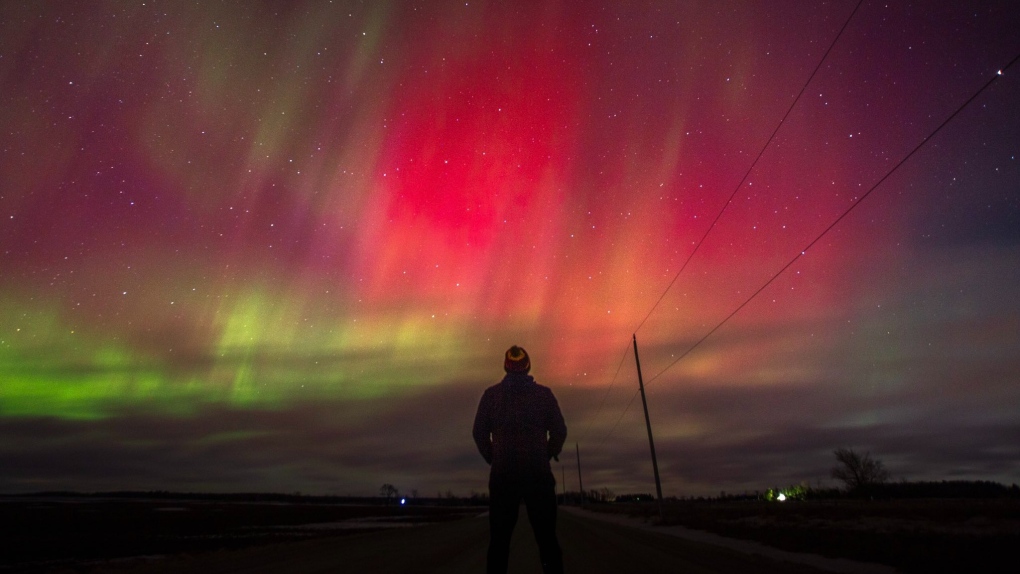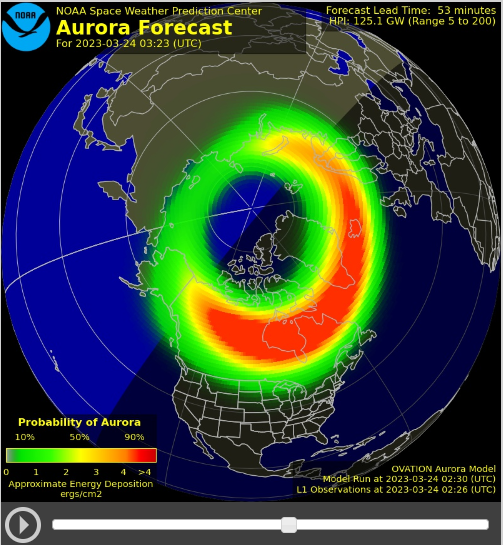Did you see the northern lights? Photos show lights dancing across southern Ontario
 The northern lights above Authur, Ont. on March 23. (Kevin Gilbert)
The northern lights above Authur, Ont. on March 23. (Kevin Gilbert)An uncommon phenomenon lit up the skies across southern Ontario on Thursday night, including in Waterloo region where the aurora borealis – also known as the northern lights - shone bright enough to be seen with the naked eye.
According to the Government of Canada, auroras occur when charged particles - electrons and protons - collide with gases in Earth's upper atmosphere. Those collisions produce tiny flashes that fill the sky with colourful light.
The light display was a result of an Earth-facing coronal hole on the sun and solar winds, according to National Oceanic and Atmosphere Administration (NOAA)
On Thursday night these flashes were so bright they were visible across southern Ontario.
People took to social media to share their photos of the phenomenon.
A photo shared on Twitter appears to show the lights above Glenridge Plaza in Waterloo just before 11 p.m.
While the lights were visible in the city, those living in more rural areas were able to see vibrant colours streak across the sky.
Armature photographer Kevin Gilbert(opens in a new tab) shared a series of photos on Twitter showing streaks of green and red stretching across the sky above Arthur.
The forecast form the NOAA shows the probability of seeing the aurora was high Thursday around 2:30 a.m.
 A projection of the aurora borealis for March 24. (NOAA)
A projection of the aurora borealis for March 24. (NOAA)
The brightness and location of the aurora are typically shown as a green oval centred on Earth’s magnetic pole. The green ovals turn red when the aurora is forecasted to be more intense, the NOAA websites reads.
WHEN CAN YOU SEE THE LIGHTS NEXT?
If you missed the lights last night, you may be in luck as increased solar activity is expected to continue Friday night.(opens in a new tab)
A forecast form the NOAA shows geomagnetic storms are likely on March 25 and 26(opens in a new tab), with an experimental aurora viewline showing the southern extent of where(opens in a new tab) the aurora might be seen stretches into southern Ontario.
According to the NOAA, a geomagnetic storm watch is in effect until from March 23 to 25.
To monitor the aurora forecast in the northern hemisphere click here.(opens in a new tab)
“Solar wind speeds are likely to be in excess of 600 km/s and continue into 25 March, resulting in isolated G1 storm levels(opens in a new tab),” the agency said.
Correction
An earlier version showed the NOAA model forecast as upcoming. This has been changed to reflect it was Thursday nights forecast.
Must Watch
Top Videos
CTVNews.ca Top Stories

'It's not realistic': Former PM Chretien thinks Trump will back off trade war
Former prime minister Jean Chretien says U.S. president-elect Donald Trump is likely to walk back his threat of punishing tariffs and the resulting trade war with Canada, because the Americans are too reliant on a number of Canadian exports, namely in the energy sector.
This Canadian teen lost her hands and feet to an infection. She's on a mission to share her story
A Canadian teen is reaching audiences around the world with powerful social media videos showing life without hands and feet – the price she paid after developing sepsis.
2 hours ago
Vancouver strip club's X account suspended over cheeky marquee message
The marquee at The Penthouse strip club in downtown Vancouver is known for its edgy comments on politics and pop culture.
'I'll never call him dad again:' Gisele Pelicot’s daughter says she suspects her father also drugged her for sexual abuse
Caroline Darian, the daughter of Gisele Pelicot who sustained years of horrific sexual abuse by her then-husband and other men, has described how she’s certain her father drugged her and strongly suspects she was raped too.
2 hours ago
UPDATED | Tough lesson: Thousands of 'unqualified' teachers in Quebec schools
Monique Henry has been teaching English in Quebec for the better part of two decades without official certification. As a so-called "unqualified" teacher, she has had to learn her profession the hard way.
40 min ago
NEW | West Kelowna fire chief says L.A. devastation a haunting reminder of B.C. blaze
The fire chief of a British Columbia community devastated by a fast-moving wildfire in 2023 says it's "haunting" to see similar circumstances playing out in Southern California.
16 min ago
NEW | 'A miracle.' James Woods posts on X that his house survived Los Angeles wildfires
Actor James Woods says his house in Pacific Palisades has survived the Los Angeles wildfires that had devastated much of his neighbourhood.
52 min ago
No 'water system in the world' could have handled the L.A. fires. How the region could have minimized the damage
Even as flames in Southern California continued to carve a destructive path on Friday and fire officials sought to assess the damage and determine how the fires began, a larger question loomed: Could this level of devastation somehow have been minimized, or is this simply the new normal in an era of climate-related calamities?
1 hour ago
'I didn't want to go cold turkey:' Environment Canada's David Phillips on why he keeps working after retirement
When Environment Canada Senior Climatologist David Phillips retired this past September, he wasn’t quite ready to call it a career.

























































